Israeli National Maritime Museum, Haifa – Visitors Guide
The Israeli National Maritime Museum showcases over 5,000 years of history and maritime archaeology in the Mediterranean Basin.
Note: Do not confuse the National Maritime Museum with the Clandestine Immigration and Naval Museum. Both of these museums are located within a short walking distance from each other, but represent different centuries. While the National Maritime Museum shows ancient times, the Clandestine Immigration and Naval Museum concentrates on the 19th century.
Table of Contents
Map
The National Maritime Museum is located at Derech Allenby 198, Haifa.
Directions for drivers: Link to Waze and Link to Google Maps
Directions for public transport: Link to Moovit
Interactive map of the area:
Directions
You can reach the museums by car or by public transport. Different buses pass nearby. Here is a link to Moovit, where the Destination is already set. Simply change the starting point to your location, and you will receive the updated directions (for public transportation).
Parking
I found parking along Derech Allenby Street, not far from the museum. And I can suggest you do the same.
Entrance Fee
The National Maritime Museum, Tikotin Museum of Japanese Art, and Haifa Museum of Art are part of the six Haifa Museums. Hence, you can purchase a combined ticket or a single ticket to this museum. Here is a screenshot from the Haifa Museums site:

Coupons and Discounts
Currently, there are discounts for Mizrachi Tfahot card members and holders of different credit cards (Isracard, Cal, MAX). There are also discounts for HTZone members and the teachers association. But these benefits are changing over time. Thus, I suggest searching the web for deals and coupons before your visit.
Opening Hours

Opening hours and entrance fees were updated in July 2025. In any case, recheck the official site before visiting the museum.
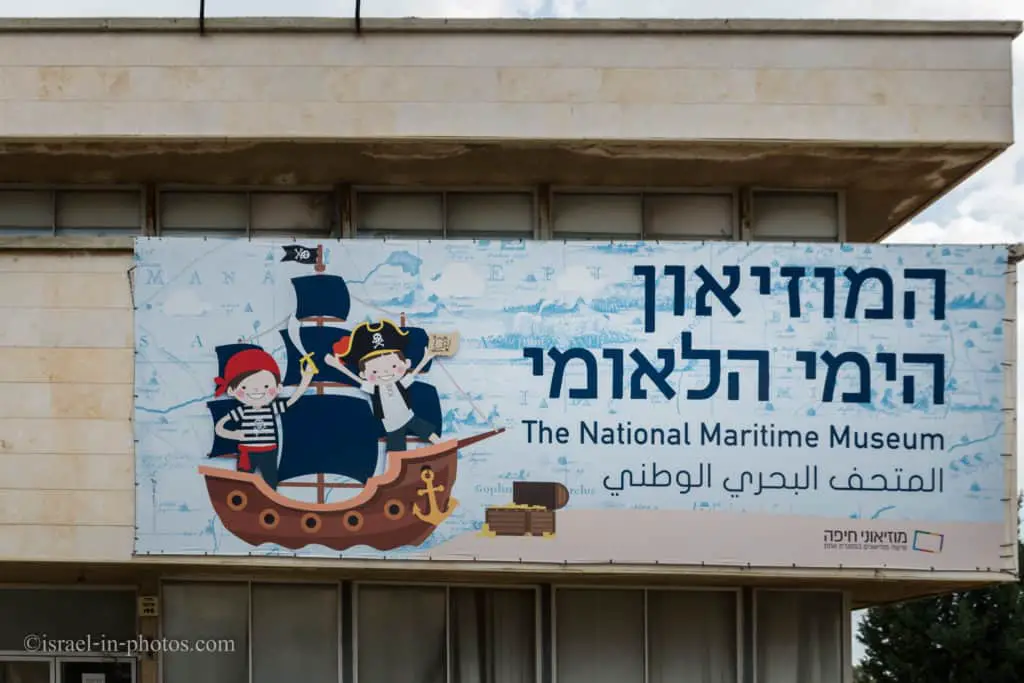
About
The National Maritime Museum in Haifa showcases the history of shipping in the Mediterranean Basin and the maritime story of Haifa. The museum displays over 5000 years of history and maritime archeology. It makes it possible for its visitors to encounter and learn about ancient ships, anchors, battling rams, and other archeological findings, such as gold coins treasures that were found in marine excavations. The museum also displays the pirate exhibition and the Hebrew-shipping endeavor.
Note: unless stated otherwise, all comments were taken from the official site.
History
The National Maritime Museum was established in 1953 from the private collection of its founder and first director, Aryeh Ben- Eli. In 1972, with donations from the Morrison Fund from London, Haifa Municipality, and friends from Israel and abroad, the museum moved to its current abode. In 1995, the museum’s collection of ancient art was added to the National Maritime Museum collection. Thus alongside exhibits from marine archeology, visitors can also view and encounter ancient Phoenician, Greek, and Roman sculptures and exhibits.
From its inception, the National Maritime Museum has aspired to display maritime history and make it possible for the general public and new audiences to encounter the stories and exhibits from the Mediterranean Basin. The three-floor museum sprawls over 3,500 square meters and includes two permanent exhibitions on two floors, a hall for changing exhibitions, collection rooms, offices, and research rooms.
Technology and Marine Instrumentation
We started on the upper floor with the Technology and Marine Instrumentation.
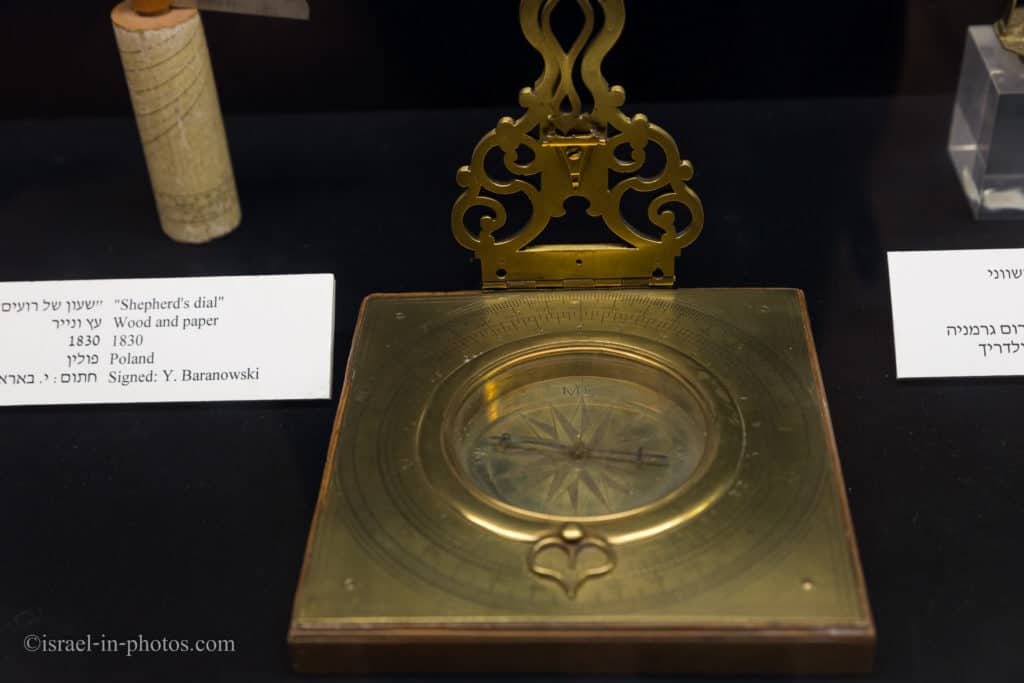
Technology and Marine Instrumentation – an exhibit of ancient marine navigation instruments, among them hourglasses and travel books from the 17th and 18th centuries, ship compasses/binnacles, sundials, and instruments used for navigation, sailing, and various measurements.
In the next photo, you can see the Qibla (Kiblah). It is an Islamic navigation instrument. It is a variation of the compass dial, which enables the azimuth of the Qibla – the Ka’abah of Mecca, and thus determines the time and direction of the prayer.

They were usually made of brass and wood. These Qiblas were constructed during the 18th and 19th centuries in Persia, Turkey, and North Africa.
Then we continued to the Years of Shipping collection.
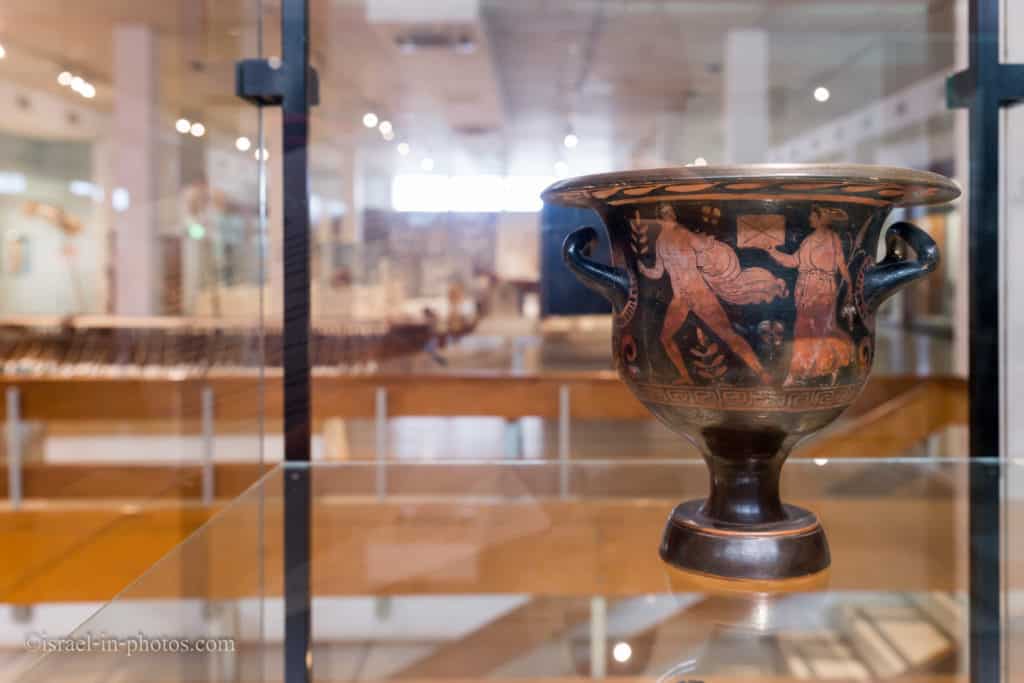
The Athlit Ram
One of the most critical and rare discoveries of underwater archeology in Israel is the Athlit ram. The late Yehoshua Ramon discovered it in 1980 in the northern bay of Athlit.
A ram is a weapon attached to a vessel’s prow at or below the water line and was intended to ram enemy vessels.

The Athlit Ram is one of the largest bronze castings ever discovered. The bronze is of high quality, weighing 465 kg.
The four symbols on the ram are integral to the casting process. They are Poseidon’s trident, a helmet surmounted with a star – the sign of Dioscuri, an eagle’s head, and a caduceus – the wand of Hermes. These symbols appear on coins minted in Cyprus between 204 and 164 BCE. That allows researchers to estimate that the ram was made in one of the Cypriot ports and was intended for a vessel in the fleet of Ptolemy V Epiphanes or his successor, Ptolemy VI Philometor.
You can see the ship’s model and the ram on the red background in the following photo.

The Lod Mosaic
A routine archaeological inspection carried out in 1996 in Hahalutz Street in Lod (ancient Lydda) and the subsequent rescue excavations carried by Miriam Avisar on behalf of the Israel Antiquities Authority, uncovered one of the largest and most impressive mosaics ever found in Israel. Approximately 160 m2 in size, the mosaic is comprised of several panels that depict mammals, birds, fish, sea monsters, merchant ships, and geometric and floral patterns.
The mosaic-covered the floors of a large affluent Roman villa and is dated to the late 3rd or early 4th century CE (Late Roman Period).
During the excavations of 1996, the site was open to the public for two days only when approximately 20,000 people came to see it.
Here is only one panel of the 160-square-meter mosaic:

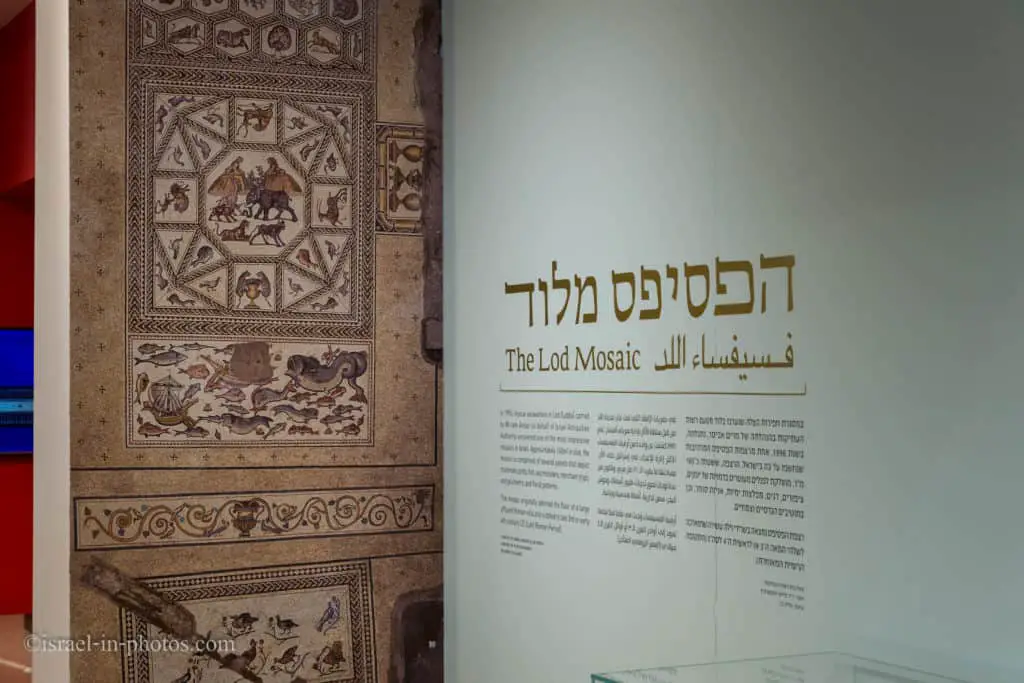
However, due to a lack of funds for its removal and conservation, the mosaic was covered once more with dirt for its preservation. After a generous donation by the Leon Levy Foundation and Shelby White, the mosaic was uncovered yet again in 2009, removed from situ, conserved, and prepared for display.
During the excavations of 2009, the site was open to the public for only one day when approximately 12,000 people visited it.
In 2010, The Lod Mosaic was displayed in The Metropolitan Museum of Art, as the first in a series of exhibits throughout the world that included The Hermitage, The Field Museum, Musée du Louvre, and The Altes Museum. More than 1 million visitors have seen the mosaic during this time.
The National Maritime Museum in Haifa is the first museum in Israel to display any section of The Lod Mosaic. The section that is displayed depicts a maritime scene with two merchant ships typical of the period and richness of marine life.
Shipwrecked Cargoes

The Mediterranean, especially the eastern basin, is known as the cradle of shipping in the western world because of its nearness to those lands where man’s cultures and states began at the dawn of history. That is where the necessity and possibility of barter and trading started between the various cultures. We have evidence from the beginning of the 3rd Millenium BCE of the trading vessels that sailed the Mediterranean Sea.
The cargo of such a vessel might weigh as much as 100-500 tons. Despite the limitations imposed by the simple square sail, these crafts were able to sail from Egypt to the frontiers of the northern shores of Lebanon. Transport by land was much more costly because loading 100-500 tons onto donkeys or mules would require more than 5000 animals and the same number to accompany them. Such a caravan would take two or three months to reach its destination. As international trade increased, the preference was for maritime transport.
Conditions in the Mediterranean are better for shipping than in the other oceans of the world, mainly because of the lack of tidal fluctuations. Secondly, there are calm weather conditions throughout the summer months, good visibility of the shore by day and the stars at night, and relatively stable winds. All these assisted seafarers find their way, whether along the coast or in mid-ocean, to their destinations.
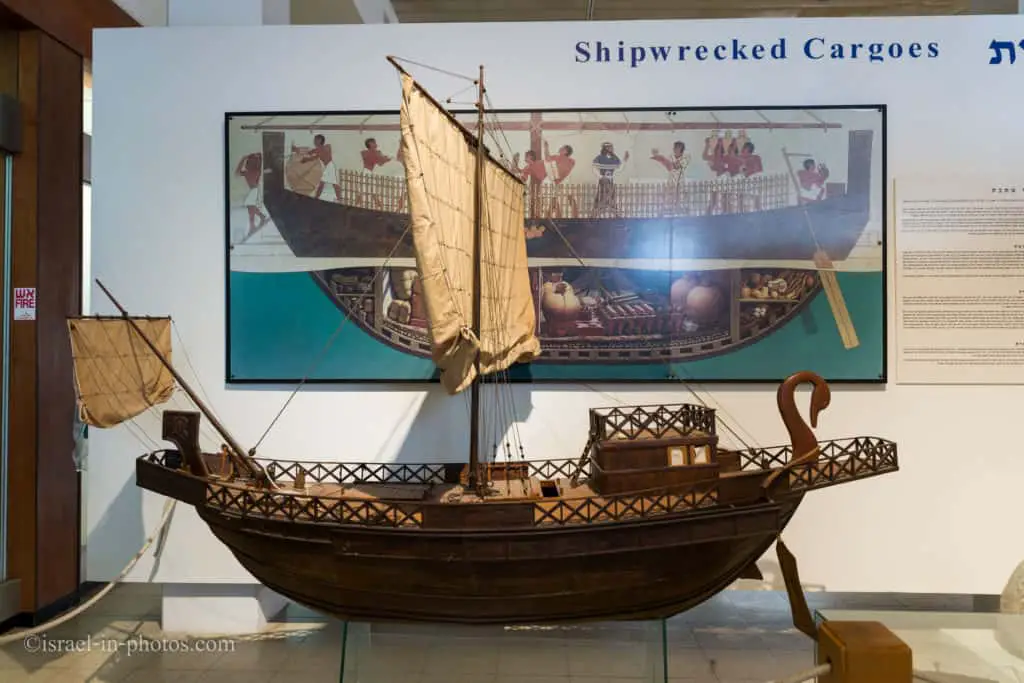
The coast of Israel extends for about 180 kilometers ( from Rosh Hanikra in the north to Rafiach in the south) along the route between the sandy shores of Africa and the indented coast of Europe with its many islands. Haifa Bay is comparatively large, exposed to winds from all directions so that there is no protection or shelter for shipping against the storms that rage along the entire coast. Storms that burst without warning, lack of shelter, and the limited maneuverability of the early sailing ships were all conducive to the fact that a ship in distress could be dragged from its moorings and sink.
The ship then capsized and was abandoned by its crew struggling to reach the shore, after which the vessel broke up, and parts of it fell to the ocean floor, where they became covered with a layer of sand. After the storm subsided, part of the cargo was retrieved, and the ship’s timbers that had been cast ashore were collected and used by the local inhabitants or by the survivors. After a few years, all that remained were remnants of the hull and heavy objects that had sunk into the sand of the sea-bed, silent witnesses to the catastrophe. Because of the large number of vessels sailing along the coast, and the increasing number of wrecks, the coastal waters of Israel are a kind of gigantic graveyard for old ships.
Rich and varied findings are discovered at the site of a wreck; parts of the vessel itself, items from the cargo, the crew’s personal effects. The timbers are usually found in anchorages or harbors that are closed and protected, while on the open beaches we often discover metal artifacts that have survived the storms. At the site of the wreck itself, many items of the cargo are found, but we can also assume that much was already removed in antiquity.
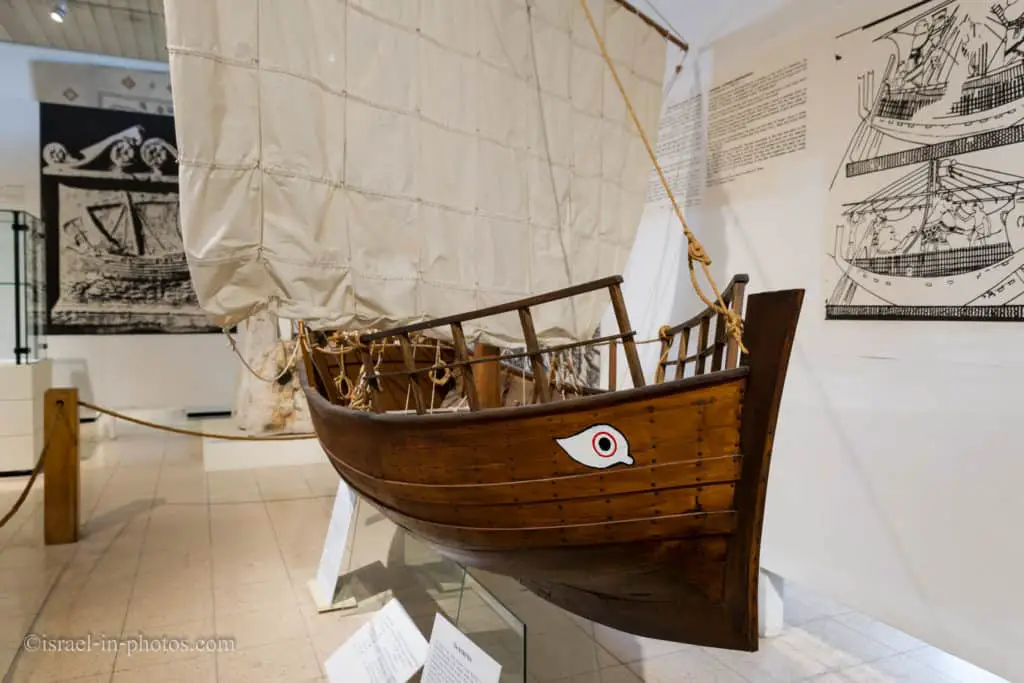
That was the end of the upper floor. Thus, our next stop was at ground level.
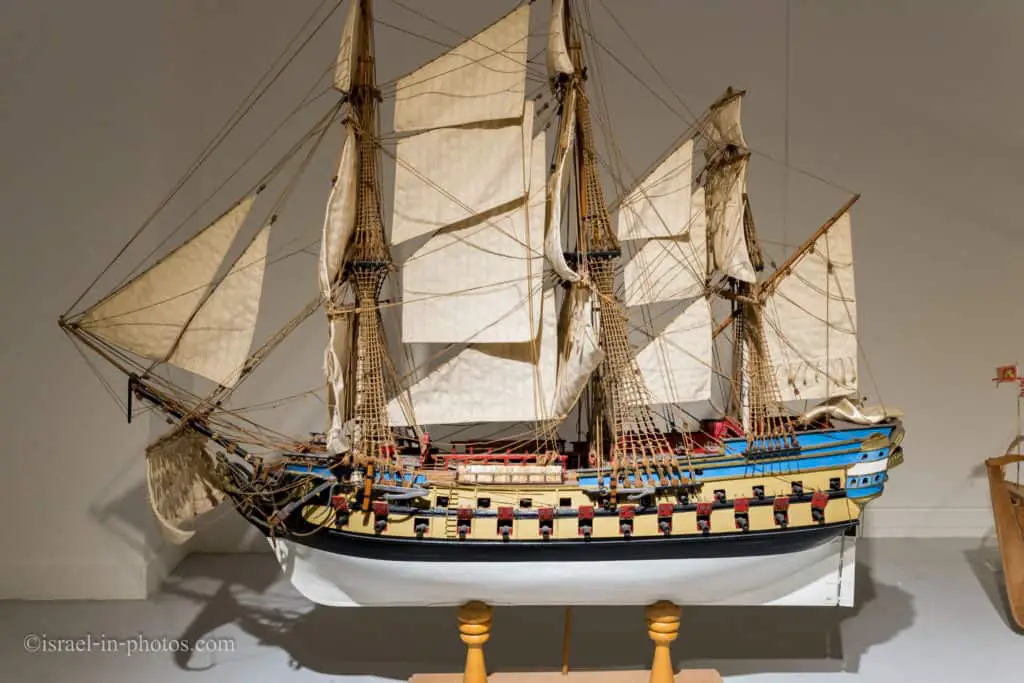
On the ground floor, we saw several models of ships, including Le Protecteur. This French warship was built in 1760 and measured 74 meters in length, 14 meters in width, and 64 meters in height. And since it was a warship, it had 74 guns.
Le Protecteur is a typical warship that served till 1789. And during the American War of Independence, it participated in the Battle of Granada (1779).
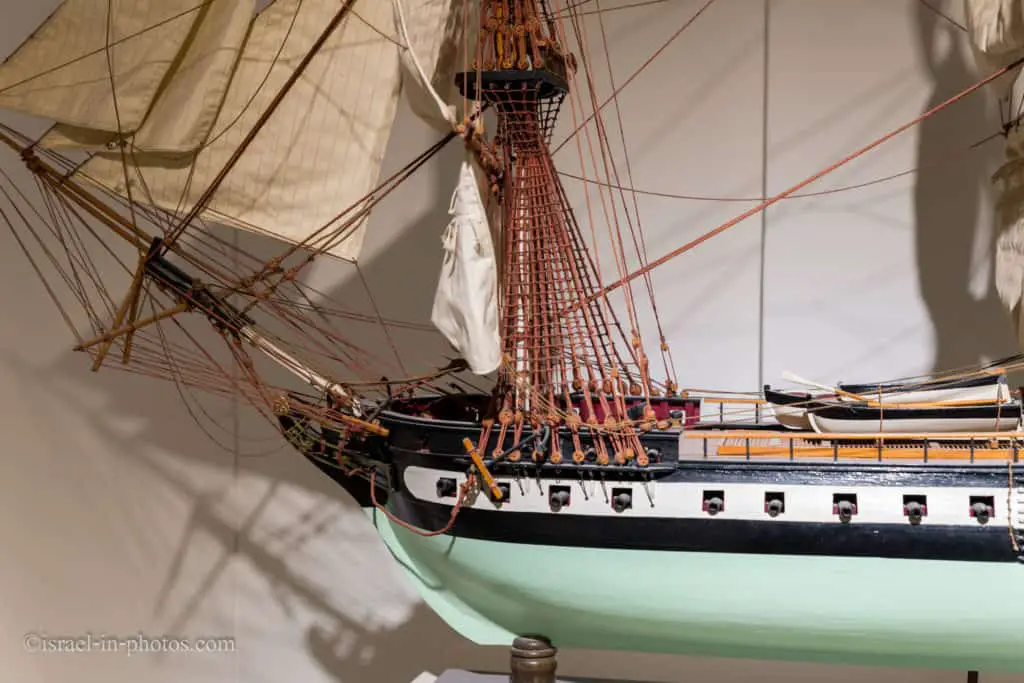
There were several other models, and then we moved to the main exhibit on this floor.
Shikmona and Its Treasures
For additional info about the Tel, see Tel Shikmona.
Shikmona Mosaics
Many mosaics from the Byzantine Era were revealed during the excavation of Tel Shikmona. The most spectacular mosaics were found in the northern quarter and among the ruins of a monastery. Here is one of them.

A broader view of the mosaics and the ship models.

Pirates: The Skull and Crossbones
The ground floor has only one room. And after seeing the mosaic, we continued to the underground level. The first thing we saw was the Pirates exhibition.

Ever since man began maritime trading, piracy – robbery at sea – has been a means of survival. Piracy is a worldwide phenomenon and was first recorded in the Mediterranean at the end of the 2nd millennium BCE, and in the China Sea in the middle of the 1st millennium CE. However, the most notorious pirates plied the Atlantic Ocean, beginning with Sir Francis Drake of England, in the 16th century.
A pirate is one who robs and plunders at sea, an individual who will attack any vessel for his gain. At different times and places, piracy has acquired different names, but all pirates seek riches and disregard the dangers involved in their acquisition. The privateer was an armed vessel, or the captain and his crew of such a vessel, who had received a legal license – a “letter of marque” – to attack enemy shipping. Privateers sailed the Atlantic and Pacific Oceans and the Caribbean in the 13th-19th centuries. Similarly, the Corsair was the privateer of the Mediterranean in the 14th-19th centuries. The pirates who plied the Caribbean and the shores of Central and South America in the 17th century were known as buccaneers, a term originating from the hunters of the Island of Hispaniola (today Haiti). The French term for buccaneer was the filibuster.
In this exhibition, we learned about Scrimshaw.
Scrimshaw
Scrimshaw is scrollwork, engravings, and carvings done in bone or ivory. Typically it refers to the artwork created by whalers, engraved on the byproducts of whales, such as bones or cartilage. It is most commonly made out of the bones and teeth of sperm whales, the baleen of other whales, and the tusks of walruses. It takes the form of elaborate engravings in the form of pictures and lettering on the surface of the bone or tooth, with the engraving highlighted using a pigment, or, less often, small sculptures made from the same material.
However, the latter fall into the categories of ivory carving, for all carved teeth and tusks, or bone carving. The making of scrimshaw began on whaling ships between 1745 and 1759 on the Pacific Ocean and survived until the ban on commercial whaling. The practice survives as a hobby and as a trade for commercial artisans. A maker of scrimshaw is known as a scrimshander. The word first appeared in print in the early 19th century, but the etymology is uncertain.
Source: Wikipedia
And we saw some raw material, including the “saw” of sawfish, teeth, and the horns of whales.

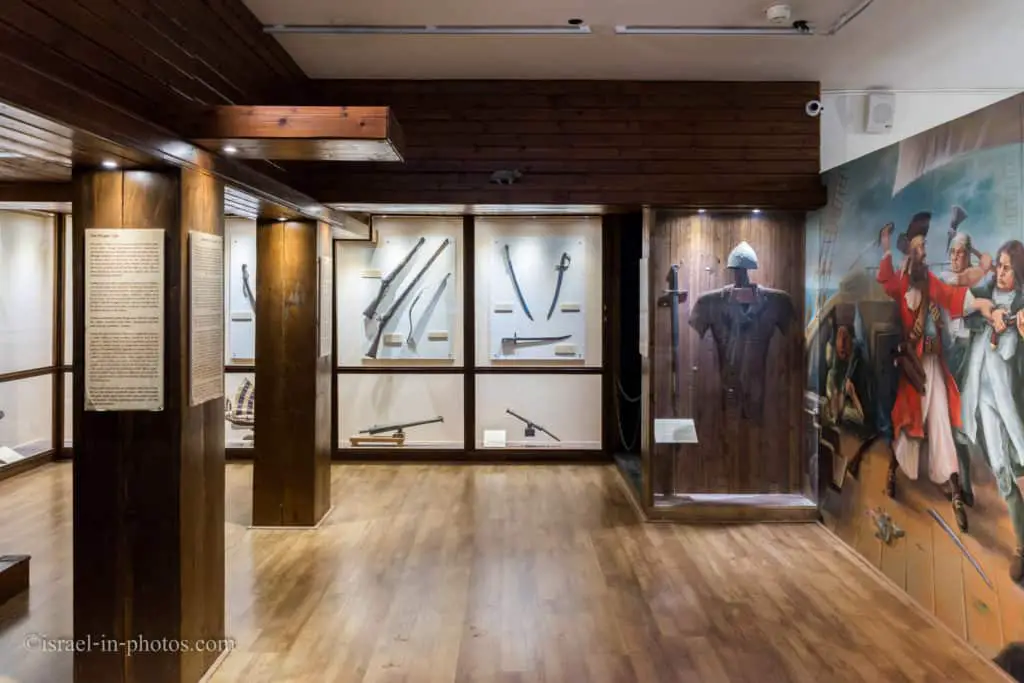
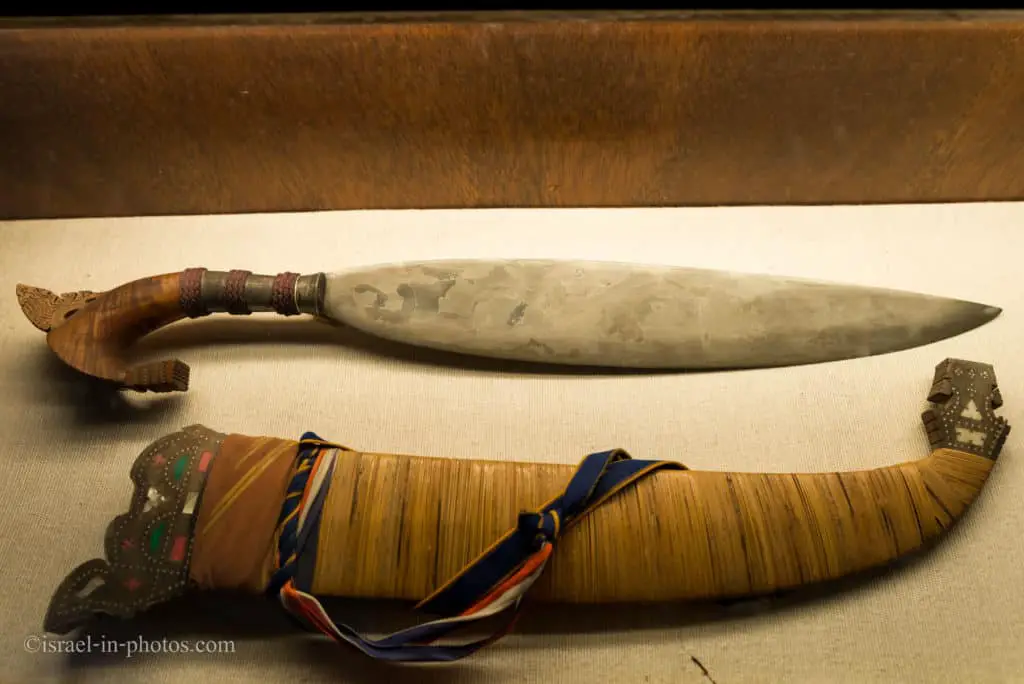

Are you familiar with all the nautical knots? I was not familiar with most of them.

Maybe it is hard to see, but this souvenir is entirely made of seashells:
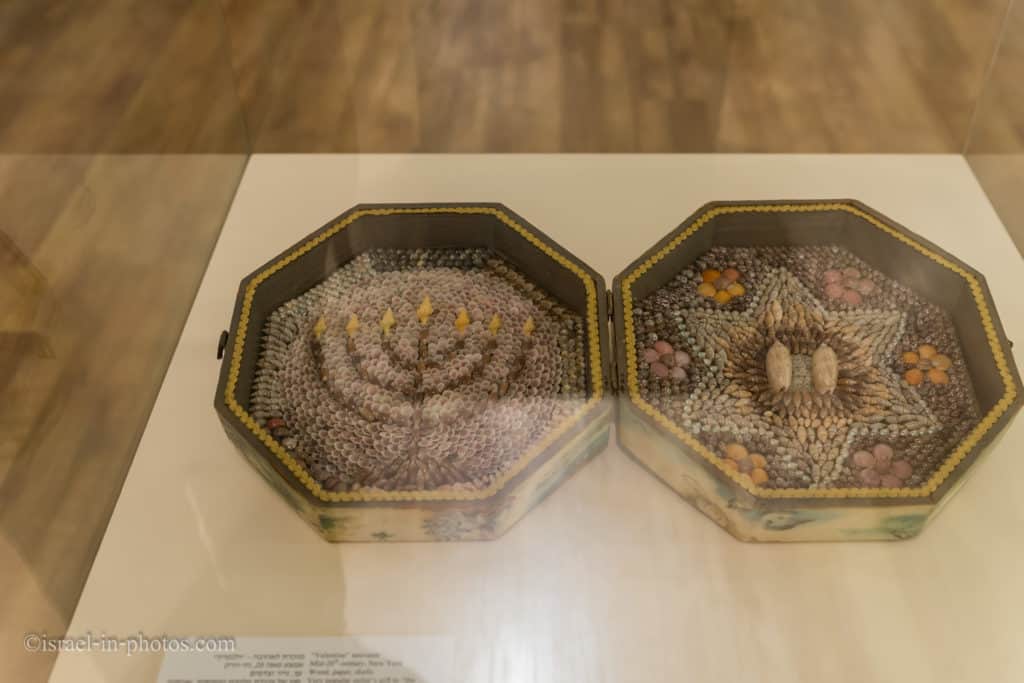
The pirate exhibition was more suitable for kids. There were movies and several interactive stands.
This 20th-century boat-shaped raft, used in Bolivia, bears a design resemblance to rafts used in Egypt thousands of years ago.

Storage Jars in Sea Trade
At the far end, you can see the Storage Jars in the Sea Trade exhibition.
In The Ethics of the Fathers, it is written “Look not on the jar but on what is contained therein” (IV, 20). This saying refers to an ordinary jar. However, an ancient jar is a different matter. “What is contained therein” certainly deserves our attention and investigation, but so does the jar itself.
Most of the storage jars were brought in by fishermen who trawl their sack-shaped nets behind their boats along the bottom of the sea. Occasionally, when the nets are raised with their catches of fish, jars which had been lying on the sea-bed are retrieved. The rest were discovered by underwater archaeological expeditions. The jars exhibited were mainly found off Achziv, Acre, Shikmona, Athlit, Dor, Caesarea, Michmoret, Ashdod, and Ashkelon.

The quote on the wall: “There are two liquids that are especially agreeable to the human body, wine inside and oil outside.”
Hebrew Shipping in the 20th century
The last exhibition we saw was telling the story of Hebrew Shipping.
In his figurative work “Altneuland,” Theodore Herzl envisioned Haifa as a city with a large, busy port from which ships were bearing an emblem of seven stars set out for all parts of the world. His suggestion for the national flag, which was not accepted by the national establishments, was adopted by the national maritime company when it was formed. Two of Herzl’s associates had proposed creating such a company, but this proposal was rejected at the early Zionist congresses because the leaders disregarded the notion that the rise of a Jewish nation in its land would require direct provision for working that land and to its agricultural settlements. Redeeming the land was the declared aim on which most of their efforts and resources were concentrated.
Hebrew seamanship was based on the Jewish establishment of the first Hebrew city of Tel Aviv. Tha, the incremental number of settlements, villages, and kibbutzim that were created after the First World War, necessitated importing vast quantities of building material. The initial dependency on Arab shipping was problematic because of constant strikes, disorganized shipping lines, and, above all, the beginning of the Arab uprising and hatred of the Zionist ideal. To respond to the urgent need to serve the Jewish settlers, initiatives were taken by those who had acquired much maritime experience in their countries of origin, among them adventurers and contractors, who initiated Israel’s first shipping companies.
First Attempts
Essentially, these companies were intended for passenger and goods transport, and fishing. Some of these attempts were doomed to failure from the outset. Halutz (Pioneer) was the first vessel owned by Jews, acquired in 1919 by a Jew who had dreams but no maritime experience, which was wrecked after a short time. Hetz (Arrow), a Scandinavian fishing vessel acquired in 1928, was unsuitable for fishing in the Eastern Mediterranean. The worst failure was the loss of the Emanuel, acquired communally as the basis for forming a company, which was lost with all hands while sailing from England to Greece in 1934.
However, there were also some successes, and in 1928 the first Israeli captain, Zeev Hayam, was given command of the Gozal (Chick), a cargo boat belonging to the Nesher Cement Company. In 1926 Hayam was a member of a sailing group on the River Yarkon. For many years afterward, he was a very active seafarer, connected both to the Jewish settlement and to the State of Israel. The Dizengoff Company was founded during the Turkish regime, and in 1934 the Atid company was established, an effective outlet for Jewish naval students who would use man vessels in companies established later, and in the illegal immigrant ships and the navy.


Galilah Vessel
This exhibition tells the story of many people, firms, and ships. Here is, for example, Galilah:

The American Railroad Co. built Galilah in 1913 for cruising the Hudson River. During WWI, she was handed over to the U.S. Army and became a troop transport. After the war, she returned to cruising and was renamed De Witt Clinton (former Mayor of New York).
During the American Depression, she lay idle, but during World War II, she was put into service as a troop transport and renamed again, this time after Colonel Frederick Jonson.
In 1948, Zim acquired it, and as a troop carrier, it was suited to bringing new immigrants to Israel. In 1948-1949, she assisted in the relocation of over 10,000 immigrants.
When the immigration wave ended, Galilah returned to the Haifa-Marseille route. In 1952, when new vessels entered service, she was taken out of use and later sold for scrap.

Since we mentioned Zim, which played a significant role (and still does) in Israeli history, I would like to discuss it.
Zim Integrated Shipping Services
It is the largest cargo shipping company in Israel, and one of the top 20 global carriers, with headquarters in Haifa and Virginia.
Early Years
ZIM was founded in 1945, by the Jewish Agency and the Histadrut (General Federation of Laborers in the Land of Israel). The first ship was purchased in partnership with Harris and Dixon (based in London) in 1947. This vessel was refurbished, renamed SS Kedma, and sailed to the future state of Israel in the summer of 1947. During her first years, her main task was transporting hundreds of thousands of immigrants to the emerging state. Some of the other ships that had been used for clandestine immigration before the establishment of Israel as the British mandate authorities confiscated a state and later joined the company’s fleet. The company continued to purchase more ships, among them SS Negba, SS Artza, and SS Galila.
During the 1948 war, the company was the sole maritime connection with the state of Israel, supplying food, freight, and military equipment.
Second Half Of The 20th Century
In 1953, some of the money from the reparations agreement between Israel and West Germany was allocated to the purchase of new ships. The SS Bergensfjord renamed Jerusalem, sailed the Israel-New York route. Another ship purchased with reparations money was the SS Etzel. The SS Dolphin IV, acquired in 1956, was renamed, SS Zion.
In the 1950s and 1960s, ZIM concentrated on passenger ships, alongside a constant expansion of the cargo shipping business. Passenger liners were a conventional means of international transport before the emergence of cheap air transport, and pleasure cruises were also popular. ZIM sailed the Mediterranean Sea, as well as having regular routes to the United States. Some of its ships cruised to the Caribbean during the winter. 1964 saw the completion of the ocean liner SS Shalom, which turned out to be a failure, marking the end of the ZIM passenger shipping era.
During the 1960s, ZIM started to turn its focus to cargo ships and obtained several special-purpose vessels, including refrigerated ships and oil tankers. ZIM transported crude oil from Iran to Israel through a joint subsidiary with Ghana, named ‘Black Star Line,’ and oil byproducts from Israel to Europe.
In the 1970s, ZIM expanded into the container shipping business. ZIM ordered six such ships, and gradually made this its main line of business.
In 1981, one of the company’s ships, Mezada, was lost at sea. Despite a lull in maritime shipping at the beginning of the 1980s, the company built 15 more ships in Germany in the 1990s. At this time, the ownership of ZIM was divided between the Israeli government and Israel Corporation.
Twenty-First Century
In 2014, the unloading of a Zim ship at the Port of Oakland was delayed by anti-Israel protesters. Longshoremen declined to load the ship out of safety concerns, taking no position on the underlying dispute but unloaded the ship after their safety was assured. Other protests in Los Angeles and Tacoma, Washington failed to stop the unloading of cargo from Zim ships. A second demonstration bypassed Oakland for Los Angeles when longshoremen, not participating in the protest, refused to unload the ship after being physically threatened and their vehicles blocked when they tried to report for work. Protesters’ claim they impacted the company denied Zim’s shipping schedule and the local Jewish Community Council denounced the “hateful” rhetoric of the demonstrators.
The source of the quotes above is Wikipedia
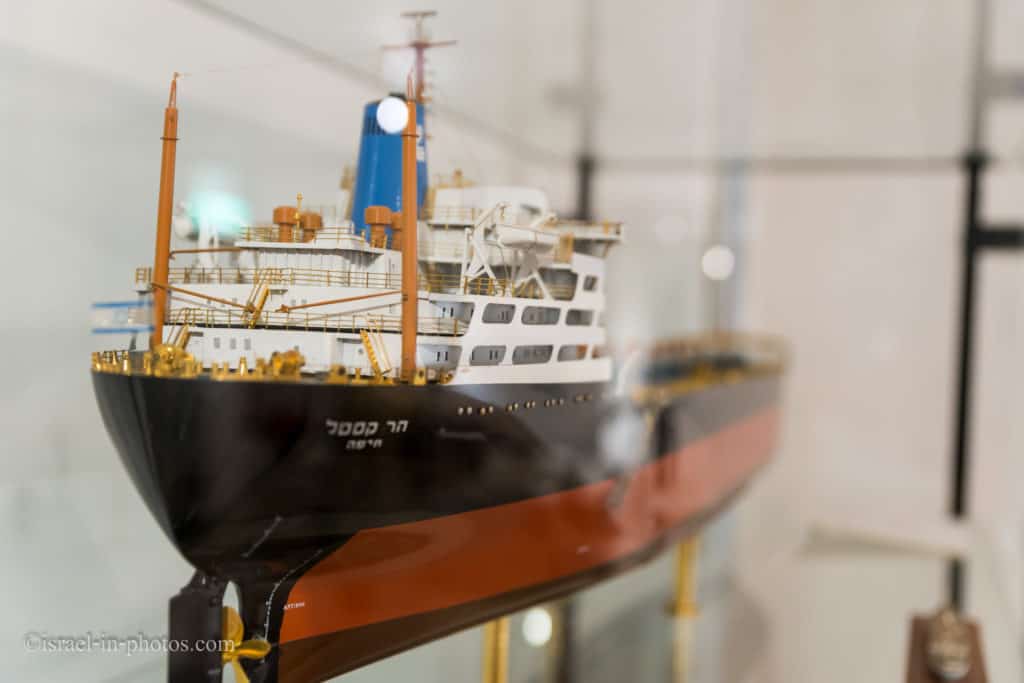

That was the last exhibition we saw, but before we head to the Clandestine Immigration and Naval Museum, I want to mention that there are temporary and permanent exhibitions, as in other museums. Thus, not during each visit will you see the same. For example, The Athlit Ram, Pirates: The Skull and Crossbones, and Hebrew Shipping in the 20th century are permanently on view, and The Lod Mosaic was a temporary exhibition. You can recheck the official site to see what exhibits are currently on display.
Summary
The National Maritime Museum is lovely. The visit took us a little less than two hours, and I recommend this museum to people interested in these topics. As for kids, younger children will not understand much. Most displays are traditional, meaning kids should read fluently to appreciate the exhibits. Therefore, if your kids are preschoolers, I suggest the nearby Clandestine Immigration and Naval Museum.
Have you ever been to the National Maritime Museum? Tell us about your experience in the comments below.
That’s all for today, and I’ll see you on future travels!
Stay Tuned!
Additional Resources
Here are several resources that I created to help travelers:- Trip Planner with Attractions and Itineraries is the page that will help you create your perfect travel route.
- What is the Best Time to visit Israel? To answer this question, we will consider the weather, prices, holidays, festivals, and more.
- Information and Tips for Tourists to Israel will answer the most common questions tourists have about Israel (including safety, passports, weather, currency, tipping, electricity, and much more).
- Israel National Parks and Nature Reserves include a complete list, top ten, map, tickets (Israel Pass, Matmon, combo), and campsites.
- If you are looking for things to do, here are the pages for Jerusalem, Tel Aviv, Haifa, Sea Of Galilee, Akko (Acre), Eilat, Nazareth, Safed (Tzfat), and Makhtesh Ramon.


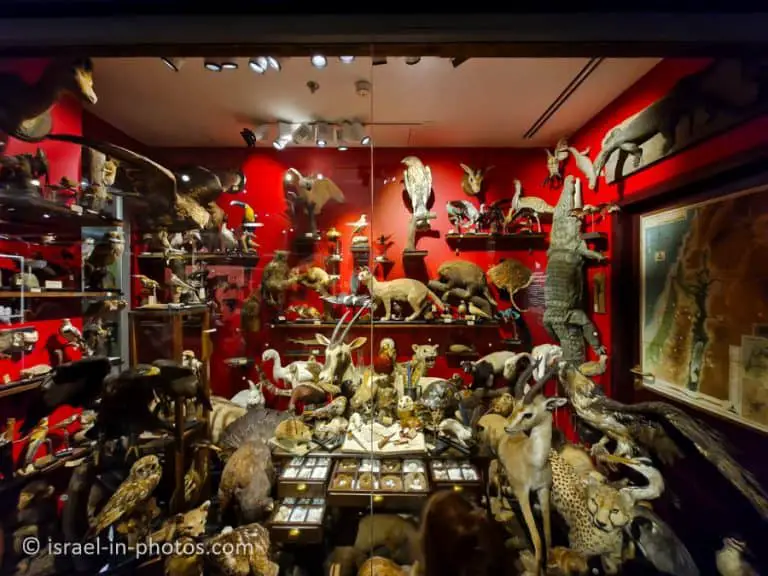



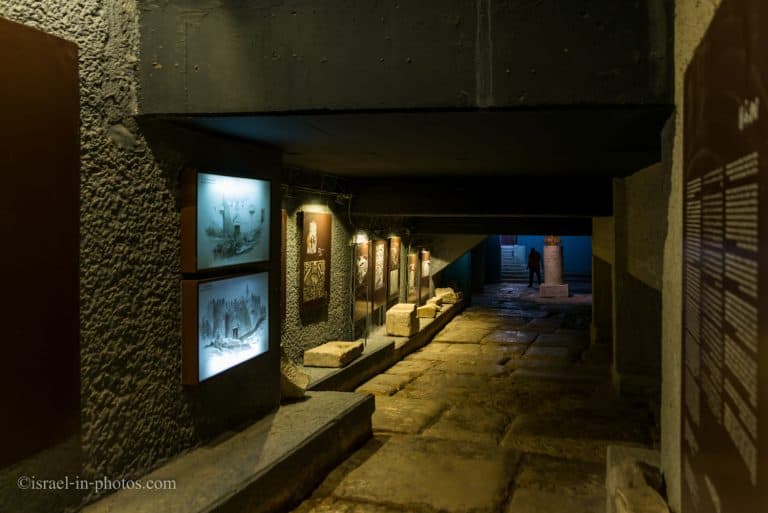
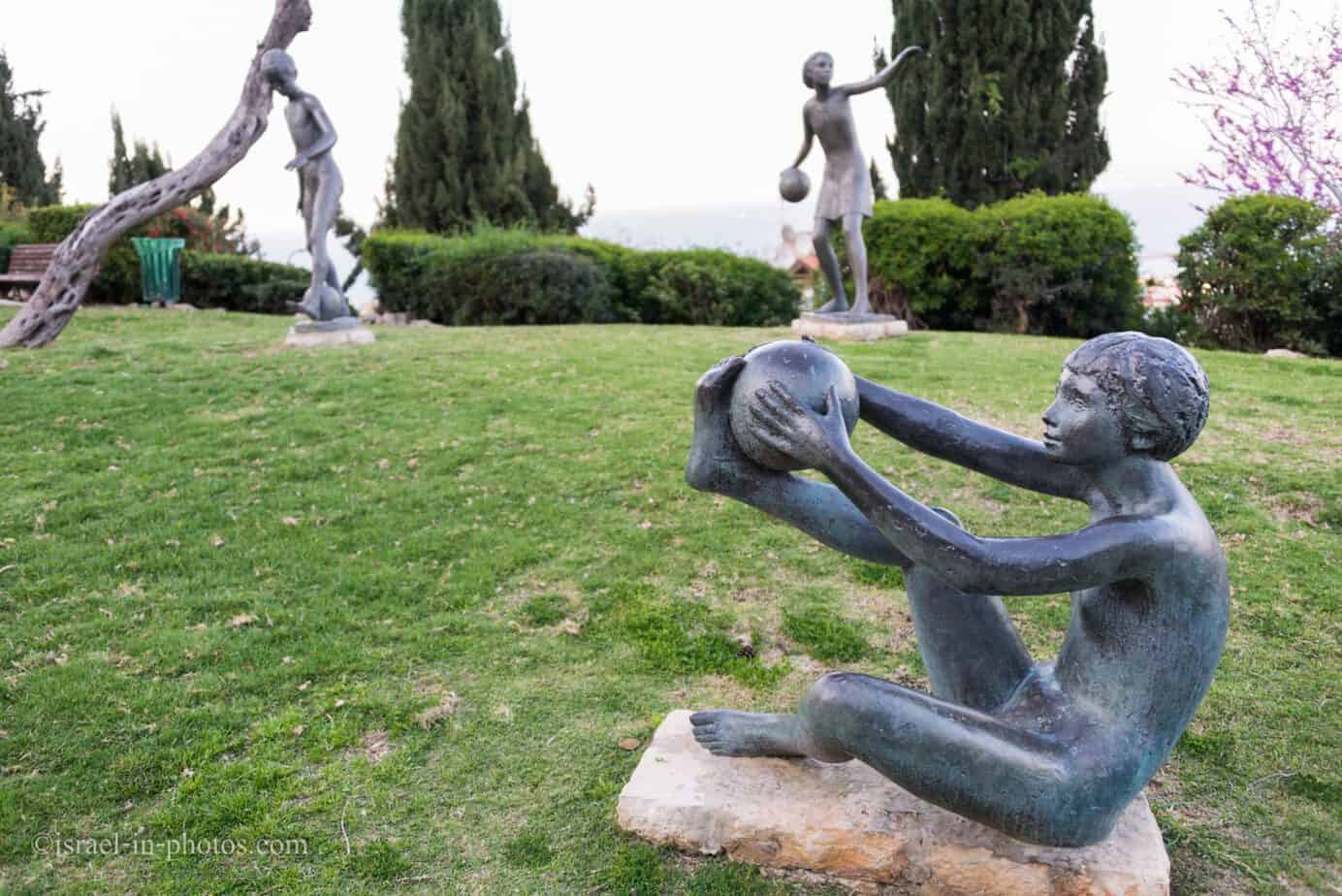
hello, my name is Sara I am trying to locate a passenger log from a trip in July 1952. My mother traveled to Israel from Marseilles to sing in the zimriya. can you help me?0528616685
Hi Sara,
Since the ship belonged to Zim, you can contact them. I checked their website and here are the details of their media relations: media@zim.com, +972 4-865-2520